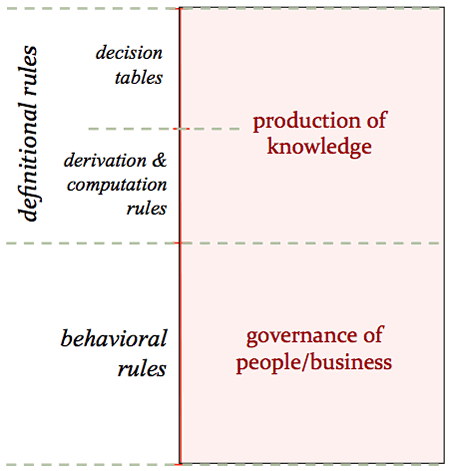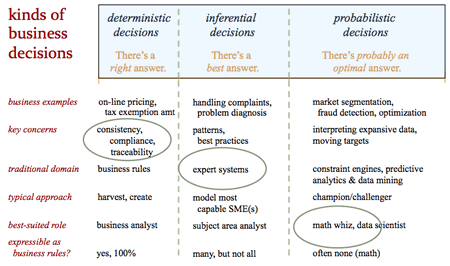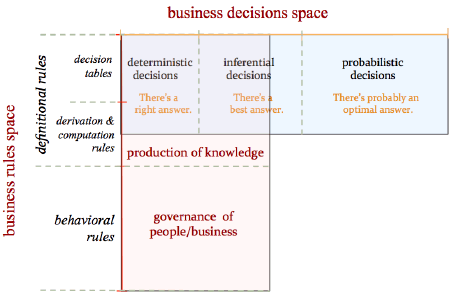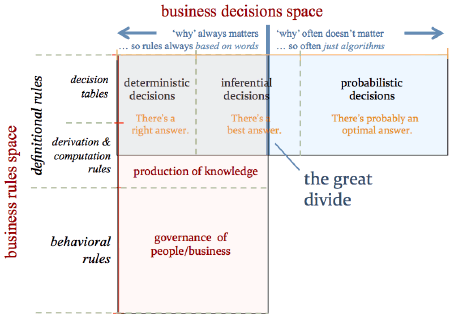Three Major Myths of the Business Decision Space — And Why They Matter to Business Analysts
The emergence of decision analysis techniques[1] is hugely important for both business rules in particular and business analysis in general. The same is true for decision tables, although current innovations[2] are more of a reinvigoration than fresh invention.[3] Every business analyst should be familiar with these decision analysis and decision table techniques.
Before we get carried away with decisions, however, we need to take a deep breath and do a reality check. This article discusses three major (and quite harmful) myths of the business decision space.
|
Definition of Terms This discussion assumes the following definitions for business rule and business decision. These are the definitions we use in all our work. They are deliberately business-oriented. (Why else include the modifier business in each respective term?!) If you come to the business decision space from a technical perspective, which despite vigorous denials most vendors and many gurus do, you'll naturally fall into all sorts of confusion. business rule: a rule that is under business jurisdiction[4] — a guide for conduct or action; a standard on which a decision or judgment may be based[5] business decision: a determination requiring operational business know-how or expertise; the resolving of an operational business question by identifying some correct or optimal choice[6] By the way, when I say business decision in the context of decision analysis, I always mean operational business decision — never a strategic or a governance decision. |
Myth #1: All business rules lead you to a business decision.
This notion is simply not true. There is extensive misdirection by vendors and consultants on this point.
Based on standards,[7] there are two fundamental kinds of business rules — not one — and they are quite distinct:
- Definitional rules give necessities for how things are defined, computed, or inferred. Definitional rules can be misunderstood or misapplied, but can never be violated. They simply define the way things are or create new knowledge from them. Naturally, definitional rules lead you toward business decisions.
- Behavioral rules place obligations on people and organizations in the conduct of on-going business activity. The crucial point about behavioral rules is that people and organizations can violate them. Think how much effort in everyday business is devoted to detecting violations and responding to them appropriately. Behavioral rules lead you toward the issue of business governance, not business decisions.
The fundamental distinction between these two types of rules is missed by most rule engines in the marketplace today. By and large, their origin lies with expert systems and their goal of mimicking intelligence, not governing business activity. If you define 'business rule' as condition-action (where actions are often inferences, but can also include such things as setting variables and calling functions), then of course you probably won't 'get' the business problem of governance and people violating rules.
Myth #2: A violation of a behavioral rule corresponds to a business decision.
The violation of a behavioral rule is purely and simply an event, not a business decision. Consider the following behavioral rule. This behavioral business rule is not unusual or atypical in any respect.
A customer that has ordered a product must have an assigned agent.
Now consider the following scenario that might play out in the business.
Scenario: An agent who represents a customer that has placed an order abruptly retires.
That event (retirement of the agent) leaves the customer without an assigned agent. That's a violation of the rule. What business decision is involved?! None whatsoever! The event simply occurred.[8] The agent herself may have made a decision to retire, of course, but that's the agent's personal decision, not a business decision. It lies in a completely different sphere.
Events like this happen all the time in running a business. If you treat every event as a business decision, you'll quickly drown in decisions.
To repeat, behavioral rules are about shaping (governing) the conduct of on-going business activity no matter when and how violations occur. As I said, most rule engines on the market today simply don't 'get' the business problem of governance and people violating rules.
Myth #3: The business rule space and the decision space are exactly the same.
Again, that notion is simply wrong. There are probably many reasons, but I'll concentrate on just one. I see the business rules problem space as illustrated in Figure 1.

Figure 1. The business rules problem space.
The business rules problem space has two key areas of concern (not just one): governance of people and organizations, and the production of knowledge.
In both areas, the central goal is always knowing why you get the results you do. Results need to be traceable and understandable by informed business people responsible for running the business. (That's why the customer-agent rule above was written as a clear English sentence.) This goal is central both for business rules supporting business decisions (definitional rules, often but not always, in the form of decision tables) and for behavioral rules.
This fundamental orientation has several important consequences.
- Business rules encode the rules of the game. Those rules can't be governed by chance. So business rules are never probabilistic or statistical.
- Business rules are always specified using words. Can you think of any games where the rules aren't written?! That's why RuleSpeak®[9] and the standard underlying it[10] insist that business rules always be self-explanatory[11] (assuming the underlying vocabulary is defined). They mandate "wholesome" expressions in structured natural language accessible to business people. Such expressions are most definitely not in the condition-action format of most rule engines on the market.
Let's now turn to the business decisions problem space. First a caveat: I'm not sure anyone today really knows the true range of that space. It's probably much larger than we currently conceive. For example, think about all the problems IBM Watson could potentially be used for!
Having said that, I see three kinds of business decisions, as indicated and discussed in Figure 2.

Figure 2. The business decisions problem space.
In one way or another, business decisions are always about production of knowledge. They fall into three basic categories:
- Deterministic decisions. Problems in this category have high need for consistency, compliance, and traceability. They seek the right answer.
- Inferential decisions. Problems in this category are the kind that traditional expert systems — inference engines — generally addressed. They seek a best answer.
- Probabilistic decisions. Problems in this category are typically addressed by sophisticated algorithms based on math and statistics. They seek reasonably good answers, especially ones that can be improved on through trial and error. Why you actually get the answer you do is of secondary importance (if any).
What happens when you overlay the business rules and business decisions spaces? Figure 3 illustrates.

Figure 3. Overlay of the business rules and business decisions spaces.
The business rules space and the business decisions space clearly overlap, but neither is even close to a superset of the other.[12]
What are the implications for professionals? Do remember that each space is quite large on its own. It's asking a lot — too much I think — to be master of the combined problem spaces.
Is the dividing line between the spaces distinct? Yes. Is it important? Yes, fundamentally, especially to business analysts. The distinction goes to the very heart of the problem that business rules address — to play by the rules, you always need to know why.[13] Figure 4 amplifies.

Figure 4. The dividing line between the business rules space and the business decisions space.
That's simply not the case for probabilistic decisions. For that kind of decision, black-box algorithms — ones deeply understandable only by mathematicians or data scientists — work just fine. But I don't expect business analysts to jump on that bandwagon. Their forte is business communication and engineering the why of day-to-day business results. For that you will always need words!
For further information, please visit BRSolutions.com
References
[1] e.g., DecisionSpeak. See http://www.brsolutions.com/b_ipspeakprimers.php (free download). ![]()
[2] e.g., TableSpeak. See http://www.brsolutions.com/b_ipspeakprimers.php (free download). ![]()
[3] Standardization of decision tables goes back at least to Codasyl, A Modern Appraisal of Decision Tables, Report of the Decision Table Task Group, ACM, New York, 1982. ![]()
[4] From the OMG standard Semantics of Business Vocabulary and Business Rules (SBVR). ![]()
[5] from Merriam-Webster Unabridged Dictionary — [rule] 1f and [criteria] 2a. ![]()
[6] Based on Merriam-Webster Unabridged Dictionary
[decision] 1b: a determination arrived at after consideration
[determination] 2: the resolving of a question by argument or reasoning
[decide]; to dispel doubt on
a: to arrive at a choice or solution concerning which ends uncertainty or contention
c: to infer or conclude from available indications and evidence. ![]()
[7] The OMG standard Semantics of Business Vocabulary and Business Rules (SBVR). ![]()
[8] You might view the event as a system-level decision, by why should we care about that? Business events and system events are not the same. They should never be confused. ![]()
[9] See www.RuleSpeak.com ![]()
[10] The OMG standard Semantics of Business Vocabulary and Business Rules (SBVR). See the SBVR Insider section on www.BRCommunity.com ![]()
[11] In expressing business rules you always have the option, but not the necessity, of adding comments, explanation, or documentation. ![]()
[12] Note the area of inferential decisions in the business decisions space that lies outside the business rules space. Those problems are based on rankings and/or priorities — highest score 'wins'. Such problems don't strictly qualify as business rule problems. ![]()
[13] Reference: "The Why Engineer™," Business Rules Journal, Vol. 14, No. 11, Nov. 2013, http://www.BRCommunity.com/a2013/b727.html ![]()
# # #
About our Contributor:
Online Interactive Training Series
In response to a great many requests, Business Rule Solutions now offers at-a-distance learning options. No travel, no backlogs, no hassles. Same great instructors, but with schedules, content and pricing designed to meet the special needs of busy professionals.










How to Define Business Terms in Plain English: A Primer
How to Use DecisionSpeak™ and Question Charts (Q-Charts™)
Decision Tables - A Primer: How to Use TableSpeak™
Tabulation of Lists in RuleSpeak®: A Primer - Using "The Following" Clause
Business Agility Manifesto
Business Rules Manifesto
Business Motivation Model
Decision Vocabulary
[Download]
[Download]
Semantics of Business Vocabulary and Business Rules